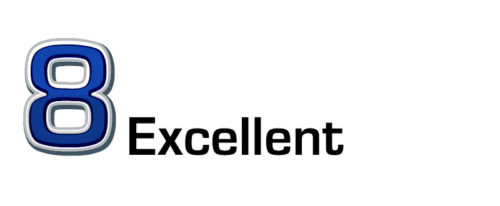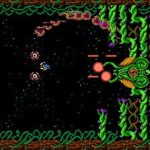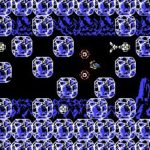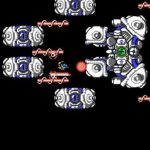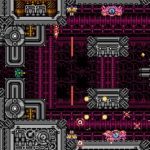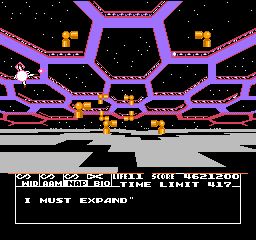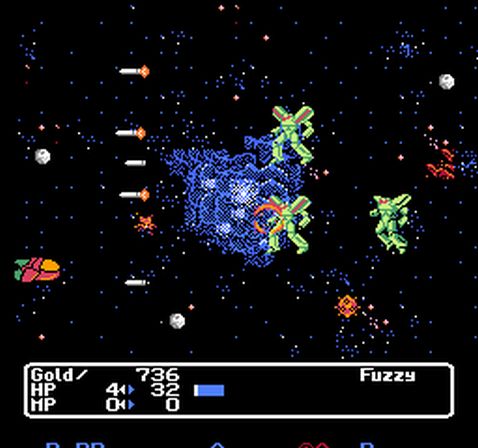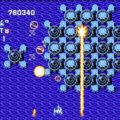Developer: Pixel Publisher: Hot B Release: 1991 Genre: Shooter
Its funny to look back on the Nintendo shooter library. Despite the system’s slow processor it built up quite an excellent library within the genre. Of course, a large part of that is due to its market dominance but that is neither here nor there. I have always been fascinated by titles that reached Europe but skipped the US. Fascinated isn’t the right word, more like jealous. The NES version of Parodius is excellent and one of my favorite shooters for the system. Another great game that gets little attention is Over Horizon. This hidden gem is one of the best shooters on the system with some great features to boot.
Over Horizon keeps its primary weapon system light. There are three main weapons: lasers, bombs, and homing projectiles. These can be upgraded three times although the differences aren’t too dramatic. In addition you can collect two options, a standard for the genre. These options mirror your fire and can be slightly re-positioned by pressing both buttons. One cool feature that more shooters needed is the ability to fire both forward and backward. This is standard in Over Horizon with good reason; it is called on a lot.
On its face the weapon system is not terribly impressive. However the game gives you the tools to customize them with its brilliant Edit mode. This mode is one of the most innovative features within the genre, enabling you to tailor each weapon with an intuitive interface. The way it works is simple; you have five points per weapon to give them characteristics of the other two. The more points allocated the more the weapon will favor that choice. As an example; say you want to modify the laser. Dumping four points into homing and one in bombs will create a homing laser that creates a small explosion on impact. It gets really interesting if you try to shore up a weapon’s weakness. The homing shot is weak but adding laser points into it makes it deadly. The game even provides a test level to test out your edits.
Options also have their own separate edit mode. These aren’t quite as extensive but are pretty fun to play around with. You can place your options anywhere on the screen, even the far edges if you like. They won’t be effective and its pretty stupid but the option is there. Since they fire in the direction you are facing you’ll have to use the test environment to see how they will play out. Truthfully, I don’t think the option edit is even necessary as the default is more than effective.
Next to its Edit Mode the level design is also what makes Over Horizon great. Each world is wildly different from the last and presents unique challenges. Compared to most shooters Over Horizon relies heavily on environmental hazards to present its challenge. Stage five features many dips in water that slow your movement as well as waterfalls that unexpectedly push you down. The ice blocks of stage three need to be manually pushed around to create passages. The tricky part is they rebound and there are also enemies that can move them around! That is not to say that the enemies are an afterthought. In fact it is easy to focus on the environment and lose sight of them, leading to a cheap death.
If there is one area that Over Horizon comes up short it is length. Six levels are around the standard length of a shooter. However Over Horizon leans on the easy side within the genre. Where death sends you into an endless spiral in other games here it is little threat. Weapon drops are very frequent, enabling you to get back up to speed in minutes. The game is very generous with respawn points as well. The only area that poses a threat are its bullet sponge bosses. With the rate you gain extra lives however most will blaze through this with little problem. With one or two more levels to explore your edits this could have been a classic.
Both artistically and technically Over Horizon is a marvel. The sprites are purposely small to allow the lavish amounts of background detail. The backgrounds are exceptional, from the giant plants and stalks of the initial stage to the ice flows of stage three. The bosses are often massive screen filling mechanical contraptions that wouldn’t look out of place in a 16-bit game. All this visual splendor does come at a cost though. There is heavy slowdown and sprite flickering which does impact gameplay. But I think it’s a worthy trade-off.
In Closing
Over Horizon is a fantastic game and should have come to the US. Its edit mode is incredibly innovative and fun to mess around with and gives the game replay value. However you play this gem it is worth, this is one of the NES best shooters.
